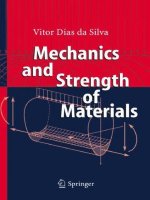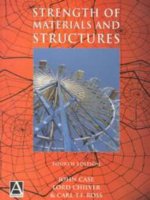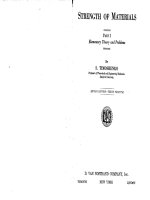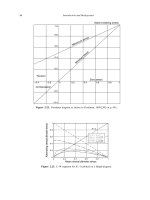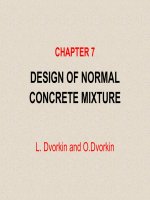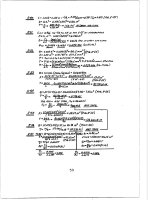Lecture Strength of Materials I: Chapter 7 - PhD. Tran Minh Tu
Bạn đang xem bản rút gọn của tài liệu. Xem và tải ngay bản đầy đủ của tài liệu tại đây (3.44 MB, 58 trang )
STRENGTH OF MATERIALS
1/10/2013
TRAN MINH TU - University of Civil Engineering,
Giai Phong Str. 55, Hai Ba Trung Dist. Hanoi, Vietnam
1
CHAPTER
7
BENDING
1/10/2013
Contents
7.1. Introduction
7.2. Bending stress
7.3. Shearing stress in bending
7.4. Strength condition
7.5. Sample Problems
7.6. Deflections of beam
7.7. Statically indeterminate beams
1/10/2013
3
7.1. Introduction
In previous charters, we considered the stresses in the bars caused
by axial loading and torsion. Here we introduce the third fundamental
loading: bending. When deriving the relationship between the bending
moment and the stresses causes, we find it again necessary to make
certain simplifying assumptions.
We use the same steps in the analysis of bending that we used for
torsion in chapter 6.
1/10/2013
4
7.1. Introduction
Classification of Beam Supports
1/10/2013
5
7.1. Introduction
Limitation
1/10/2013
6
7.1. Introduction
Segment BC: Mx≠0, Qy=0
=> Pure Bending
Segments AB,CD: Mx≠0, Qy≠0
=> Nonuniform Bending
1/10/2013
7
7.1. Introduction
Pure Bending: Prismatic members subjected to equal and opposite couples
acting in the same longitudinal plane
1/10/2013
8
7.2. Bending stress
Simplifying assumptions
1/10/2013
9
7.2. Bending stress
The positive bending moment causes the
material within the bottom portion of the beam
to stretch and the material within the top portion
to compress. Consequently, between these two
regions there must be a surface, called the
neutral surface, in which longitudinal fibers of
the material will not undergo a change in
length.
1/10/2013
Neutral axis
10
Compatibility
Consider a segment of the beam
bounded by two cross-sections that
are separated by the infinitesimal
distance dz.
Due to bending moment Mx caused
by the applied loading, the crosssection rotate relatively to each other
by the amount of d.
The Normal strain of the longitudinal
fiber cd that lies distance y below the
neutral surface.
dz c ' d ' cd y d d y
z
dz
cd
d
1/10/2013
1
2
a
c
b
d
dz
1
y
2
d
1
y
7.2. Bending stress
Neutral fiber
2
a
c
b
d
1
2
z
– radius of curvature of the neutral fiber.
y
11
7.2. Bending stress
Following Hooke’s law, we have.
z E
y
1
????
Equilibrium
Mx
Because of the loads applied in the
plane yOz, thus: Nz=My=0 and Mx≠0.
x
K
y
N z z dA
A
E
yd A 0
yd A S
0
dA
z
y
A
x
x
x – neutral axis (the neutral axis
passes through the centroid C of the
E
M y x z dA
xyd A 0 cross-section).
A
A
A
xyd A I
A
1/10/2013
xy
0
y - axis – the axis of symmetry of
the cross-section
12
z
7.2. Bending stress
M x y z dA
A
E
E
y dA I
2
x
– radius of neutral longitudinal fiber
A
M
x
EI x
1
x
K
Flexure formula – section modulus
Mx
z
y
Ix
x
Mx
y
Mx – internal bending moment
EIx – stiffness of beam
dA
z
z
y
y – coordinate of point
Mx>0: stretch top portion
Mx<0: compress top portion
=> For convenient:
1/10/2013
z
Mx
Ix
Belong to tensile zone
y
Belong to compressive zone
13
7.2. Bending stress
• Stress distribution
- Stresses vary linearly with
the distance y from neutral axis
• Maximum stresses at a cross-section
max
Mx
min
Mx
Ix
Ix
t
ymax
c
ymax
ytmax – the distance from N.A to a point farthest away from N.A in the tensile portion
ycmax – the distance from N.A to a point farthest away from N.A in the compressive portion
7.2. Bending stress
min
t
c
ymax
ymax
max
h
2
min
x
Mx h Mx
I x 2 Wx
Mx h
Mx
Ix 2
Wx
h/2
Mx
h/2
z
y
max
max min
with
Ix
Wx
called the section modulus of the beam
h/2
1/10/2013
15
7.2. Bending stress
1/10/2013
16
7.2. Bending stress
Properties of American Standard Shapes
1/10/2013
17
7.2. Bending stress
1/10/2013
18
7.2. Bending stress
1/10/2013
19
7.2. Bending stress
1/10/2013
20
7.3. Shearing stress in Bending
In general, a beam will support both shear and moment – non-uniform
bending. The shear force Qy is the results of a transverse shear-stress
distribution that acts over the beam’s cross-section.
As a results of the shearing stress, the shear
strain will be developed and (these will) tend to
distort the cross-section. This non-uniform
shear-strain will cause the cross-section warp
1/10/2013
21
7.3. Shearing stress in Bending
When a beam is subjected to loads that
produce both bending moment and shear force,
then both normal and shear stresses are
developed in the beam.
The Shear formula
Consider a beam of rectangular cross section
subjected to a positive shear force. We assume
• The Shear stresses acting on the crosssection are paralell to the shear force, that is,
parallel to the vertical sides of the cross-section
• The Shear stresses are uniformly distributed
across the width of the beam, although they
may vary along the height
1/10/2013
22
7.3. Shearing stress in Bending
Let’s consider the horizontal force equilibrium of a portion (of the
element) taken from the beam in fig. (a). A FBD of this element is shown in
fig. (b). This distribution is caused by the bending moment M an M+dM.
We have excluded the effect of V and V+dV and the transverse loading on
the FBD, because they are not involved in a horizontal force summation.
1/10/2013
23
7.3. Shearing stress in Bending
Now consider the shaded top portion of the
element that has been sectioned at y’ from
the neutral axis. This segment has the width
of bs, and the cross-sectional area of As. The
Longitudinal shear stress acts over the
bottom face of the segment (constant across
the width bs of the bottom face).
1/10/2013
24
7.3. Shearing stress in Bending
'
s
s
s
F
dA
dA
b
dz 0
z
As
As
M dM
M
s
s
s
ydA
ydA
b
dz 0
s I x
s I x
A
A
dM
s
s
ydA
b
dz
I x As
Have:
then:
1/10/2013
dM
Qy
Ix
zy
ydAs S xs
As
s
y x
s
x
QS
Ib
25
